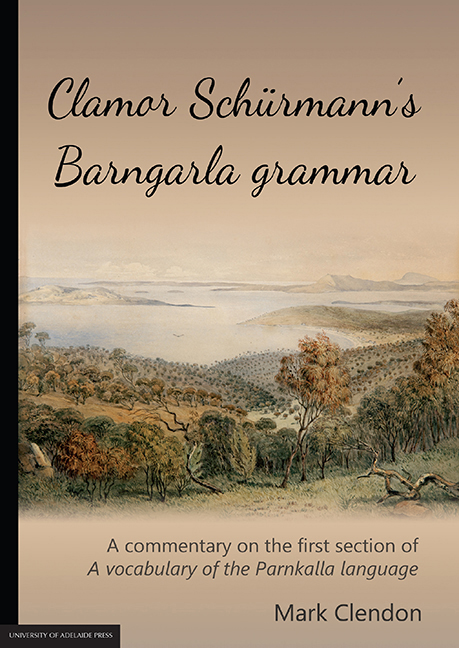 Clamor Schürmann's Barngarla grammar
Clamor Schürmann's Barngarla grammar Book contents
- Frontmatter
- Frontispiece
- Contents
- Abbreviations used in glossing sentence examples & in the text
- Preface
- Map: The northern and western Thura-Yura languages
- 1 Introduction
- 2 Writing Barngarla sounds
- 3 Pronouns
- 4 Intransitive verbs
- 5 Transitive verbs
- 6 Harry Crawford's Barngarla verbs
- 7 Suffixes on nouns
- 8 Other suffixes
- 9 Demonstrative & interrogative pronouns
- 10 Verbal derivational affixes
- 11 Non-finite verbs
- 12 Putting words together
- 13 Prospect
- Appendix The name Barngarla
- References
10 - Verbal derivational affixes
Published online by Cambridge University Press: 05 February 2016
- Frontmatter
- Frontispiece
- Contents
- Abbreviations used in glossing sentence examples & in the text
- Preface
- Map: The northern and western Thura-Yura languages
- 1 Introduction
- 2 Writing Barngarla sounds
- 3 Pronouns
- 4 Intransitive verbs
- 5 Transitive verbs
- 6 Harry Crawford's Barngarla verbs
- 7 Suffixes on nouns
- 8 Other suffixes
- 9 Demonstrative & interrogative pronouns
- 10 Verbal derivational affixes
- 11 Non-finite verbs
- 12 Putting words together
- 13 Prospect
- Appendix The name Barngarla
- References
Summary
Verbal derivational affixes are suffixes or prefixes that turn words into verbs. For example, in English the shape en turns adjectives into verbs, such as when the adjective large has en- put in front of it to make the verb enlarge ‘cause (something) to become large’, or when the adjective bright has -en put after it to make brighten ‘cause (something) to become bright’. So in Barngarla, there are a number of endings that can be used to turn words into verbs, and which can also be used to turn verbs into other verbs. A verb root to which a derivational affix has been added will be referred to as a verb stem.
Continuous derivation
Barngarla verbs may take endings that Schürmann spells -ntutu and -nturrutu, and which are probably phonemic -ndhudhu and -ndhurudhu. These endings are made up of continuous shapes -ndhu- and -ndhuru-, plus a present-tense suffix -dhu. The shape -ndhu- is found on verbs with roots ending in a or i, and the shape -ndhuru- is found on verbs with roots ending in u. These endings show us that the action of the verb is going on for some period of time. As we saw in Section 4.2.1, Kuyani has a present-tense suffix -ntya, Kaurna has -nthi and Adnyamathanha has -ntha; it is therefore likely that the shape Barngarla uses to make an ending signalling continuous aspect is -ndhu. Here are some examples that Schürmann offers:
There is a verb yanturrutu ‘catch’, but this probably contains a stem yandu-ru- and so is not a derived continuous form; it may be reflexive or mediopassive (see below).
The shape -dhu at the end of these suffixes is a normal present-tense ending, with a vowel (u) that harmonises with the vowel(s) in the shape -ndhu(ru) that comes in front of it. The verbs Schürmann presents in his vocabulary are present-tense continuous forms, and their construction is therefore as follows, for verbs with roots ending in a, i and u respectively:
The continuous shape -ndhu(ru)- can be used with other tense suffixes, and not just the present-tense one.
- Type
- Chapter
- Information
- Clamor Schürmann's Barngarla grammarA commentary on the first section of A vocabulary of the Parnkalla language, pp. 113 - 148Publisher: The University of Adelaide PressPrint publication year: 2015
